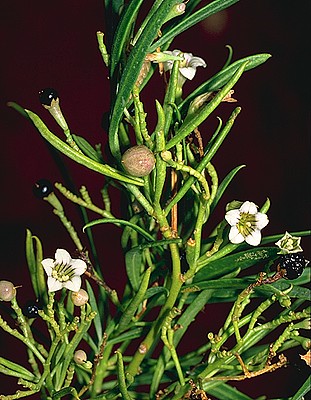
Synonymy
Duboisia hopwoodii (F.Muell.) F.Muell., Fragm. Phytogr. Austral. 10: 20 (1876)
Anthocercis hopwoodii F. Muell., Fragm. Phytogr. Austral. 2: 138 (1861).
T: near Darling River, H. Beckler s.n.; syn: K, MEL 70979.
Description
Rounded shrub to 4 m tall and 3 m wide.
Leaves narrowly elliptic or ovate-elliptic to linear, sessile (or rarely with petiole to 3 mm long), 2–12 cm long, 1–13 mm wide, concolorous.
Inflorescence narrow; bracts 0.5–4 mm long; pedicels 1.5–5 mm long. Calyx 1.5–4.5 mm long, the lobes usually about one-third as long as tube. Corolla 7–15 mm long; tube 4.5–8 mm diam. at apex; lobes 2.5–5.5 mm long. Stamens 4, 3–8 mm long. Style 3.5–6.5 mm long, equal to or shorter than upper stamens.
Berry usually globose or subglobose, rarely ellipsoid, 2–5 mm diam., purple-black; fruiting pedicels 3–5 mm long. Seeds 2–2.5 mm long.
Distribution and ecology
Widespread in arid regions of W.A., southern N.T., and S.A., extending to central-western Qld and western N.S.W.
Usually grows in red or yellow sand or sandy loam, on sandy plains, low dunes or sandy rises, often with Triodia.
Notes
Contains the alkaloids nicotine and nor-nicotine; used by Aborigines as an animal poison and as a narcotic (the name pituri also widely applied to narcotic species of Nicotiana). Toxic to horses, goats, sheep and camels; toxicity varies with locality, age and part of plant.
There are numerous references to aboriginal use of Duboisia (or Nicotiana) as pituri and a number of studies
- J.H. Maiden's extended account of Duboisia hopwoodii in The Forest Flora of New South Wales vol. 7 from p. 303 (1913)
- P.Watson (undated). Pituri, an Australian aboriginal drug. See www.drugtext.org/library/articles/912411.htm
May hybridise with Grammosolen dixonii (F. Muell. & R. Tate) Haegi and with Anthotroche pannosa Endl.
Selected specimens
W.A.: c. 20 km E of Wiluna, N.H. Speck 1331 (AD, CANB, PERTH). N.T.: c. 100 km N of Alice Springs, D.J. Nelson 1769 (AD, DNA, MEL). S.A.: c. 30 km N of Minnipa, A.E. Orchard 1778 (AD). Qld: Sandringham, 1886, G. Field (MEL). N.S.W.: c. 8.5 km N of Windara Homestead D.F. Blaxell 670 (NSW).
Derivation of epithet
Named in honour of Henry Hopwood, founder of the Victorian town of
Images and information on web
An image of D. hopwoodii can be seen on the Western Australian Herbarium Florabase site at http://florabase.calm.wa.gov.au/browse/photo?f=315&level=s&id=6966
A fact sheet for this species can be downloaded from the SA eFlora site.
Further information and images of this species in NSW can be seen on the PlantNET site.
Many references to the pharmacology of D. hopwoodii can be found on the Australian New Crops web site
An unpublished manuscript by Paul Foley, Prince of Wales Medical Research Institute,
Further references to the possible toxic properties of Duboisia species can be found with a search in the FDA Poisonous Plant Database
A discussion of the tropane alkaloids which occur in Duboisia and other Anthocercideae can be found in Griffith & Lin (2000).
Ref: W.J. Griffin & G.D. Lin (2000). Chemotaxonomy and geographical distribution of tropane
alkaloids. Phytochemistry 53: 627–628.
Plant status (if any)
Without any declared rating in W.A. – see http://florabase.calm.wa.gov.au/conservationtaxa



